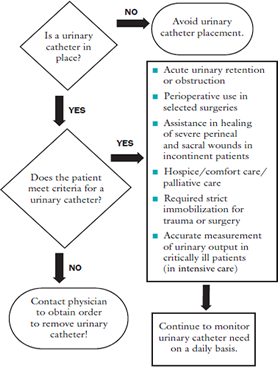Note: This brochure is a fold-out brochure, and should be folded as shown in the accompanying .pdf file.
Cover of brochure: Promptly Remove Urinary Catheters. Focus on Patient Safety
Back of brochure:
Left column:
Patient Management for Incontinence
- Turn patient every 2 hours to cleanse area and change linens.
- Use quilted pad under patient.
- Use skin barrier creams.
- Start toilet training program: Offer bedpan or commode with assist every 2 hours.
Middle column:
Urinary Catheter Initiative Champions
Right column of brochure in very large type:
Promptly Remove Urinary Catheters
Image: Drawing of a urinary catheter.
Focus on Patient Safety
Inside of brochure:
On left column of page:
Image: Drawing of a urinary catheter with a circle and line through it.
Urinary Catheter Facts
- 600,000 patients develop hospital-acquired urinary tract infections (UTI) every year.
- Of these infections, 80 percent are from a urinary catheter.
- About half of patients with a urinary catheter do not have a valid indication for placement.
- Each day the urinary catheter remains in place the risk of a UTI increases 5 percent.
In middle column of page:
Evaluation of Urinary Catheter Need

In right column of page:
Indications for Urinary Catheters
- Acute urinary retention or obstruction
- Perioperative use in selected surgeries
- Assistance in healing of severe perineal and sacral wounds in incontinent patients
- Hospice/comfort care/palliative care
- Required strict immobilization for trauma or surgery
- Accurate measurement of urinary output in critically ill patients (in intensive care)
Urinary Catheters Are NOT Indicated for...
- Urine output monitoring outside the ICU
- Incontinence
- Patients transferred from intensive care to general units
- Prolonged postoperative use
- Morbid obesity
- Immobility without a sacral or perineal pressure sore
- Confusion or dementia
- Patient request



